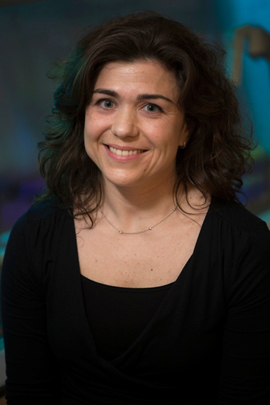MEDIA CONTACTS:
David Ruth
713-348-6327
david@rice.edu
Jade Boyd
713-348-6778
jadeboyd@rice.edu
Rice’s Laura Segatori wins NSF CAREER award
Engineering researcher creating new tools to study Parkinson’s disease
HOUSTON — (March 28, 2013) — Some human cells forget to empty their trash bins, and when the garbage piles up, it can lead to Parkinson’s disease and other genetic and age-related disorders. Scientists don’t yet understand why this happens, and Rice University engineering researcher Laura Segatori is hoping to change that, thanks to a prestigious five-year CAREER Award from the National Science Foundation (NSF).
CAREER Awards support the research and educational development of young scholars that the NSF expects to become leaders in their field. The grants are usually worth about $400,000 and are among the most competitive awards from NSF, which awards only about 400 each year across all disciplines.
Segatori, Rice’s T.N. Law Assistant Professor of Chemical and Biomolecular Engineering and assistant professor of bioengineering and of biochemistry and cell biology, will use her CAREER grant to create a toolkit for probing the workings of the cellular processes that lead to accumulation of waste material and development of diseases, such as Parkinson’s and lysosomal storage disorders. Each tool in the kit will be a nanoparticle — a speck of matter about the size of a virus — with a specific shape, size and charge. By tailoring each of these properties, Segatori’s team will create a series of specialized probes that can undercover the workings of a cellular process called autophagy.
“We’ve done a lot of studies on the biology of this process, and we work with some people at Baylor College of Medicine who are experts in this area and who have animal models of these diseases,” Segatori said. “What we are asking now is, What are the design rules to make nanoparticles that will activate this pathway?”
Autophagy is the main process by which damaged or toxic materials are broken down within cells. First, the cell recognizes that something is trash and earmarks it for disposal by bagging it in a thin sac, or membrane. These bags of trash are called “autophagosomes,” and in the second step of the process, an organelle called the “lysosome” collects the bags and empties their contents into a chamber, where they are broken down and recycled.
“In some diseases, autophagosomes form to compartmentalize the material, but they are never cleared by the lysosomes, so the autophagosomes accumulate,” Segatori said. “In Parkinson’s, for instance, neuronal cells simply cannot keep up with the amount of autophagosomes that contain the misfolded amyloid proteins associated with the disease.
“But we also know that some nanoparticles can inactivate the lysosome function because of the charge on their surface,” she said. “For instance, studies have shown that autophagosomes form to compartmentalize gold nanoparticles. At first glance, it might appear that autophagy is taking place because one can observe many autophagosomes in the cell. But in reality, the autophagosomes containing the nanoparticles are never cleared out by the lysosome. So they accumulate in much the same way that the amyloids accumulate in Parkinson’s.”
In previous research, Segatori studied a protein that acts as a trigger for both halves of the autophagic process. The protein — transcription factor EB (TFEB) — must be present for trash to be both collected and degraded via autophagy. Segatori and her team also found that TFEB plays an important role in rescuing misfolding and aggregation proteins. In the CAREER research program, Segatori will examine how cells respond to more than a dozen nanoparticles. By gauging the cell’s autophagic reaction to particles of specific size and charge, she hopes to identify other key proteins like TFEB and also learn how to regulate them.
“The idea, essentially, is to figure out the design ‘rules’ that we must follow to make nanoparticles that enhance this clearance machinery,” she said. “We want to understand the characteristics of a nanoparticle that might activate part of the process but then impair it somewhere along the line, such as gold nanoparticles do.
“Eventually, once we understand how to design a nanoparticle to activate autophagy, we will use it as a tool to learn more about the autophagic process itself because there are still many question marks in biology regarding how this pathway works,” Segatori said. “It’s not completely clear how it is regulated. It seems that excessive autophagy may activate cell death, but it’s not yet clear. In short, we are looking for more than therapeutic applications. We are also hoping to use these nanoparticles as tools to study the basic science of autophagy.”
###
High-resolution IMAGES are available for download at:
https://news2.rice.edu/files/2013/03/0328-CAREER-Segatori-lg.jpg
CAPTION: Laura Segatori
CREDIT: Jeff Fitlow/Rice University
A copy of the NSF grant abstract is available at:
http://www.nsf.gov/awardsearch/showAward?AWD_ID=1254318


